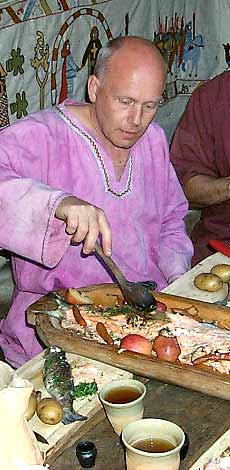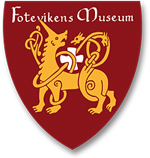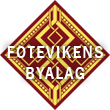Small culinary cook book for Vikings
Culinary things
 By Jan Mellring
By Jan Mellring
We all know the popular image of the Viking as an unrestrained drunkard, but how much truth is there really to this image? And what else may our Viking have put in their belly? At various Viking events I have tried to research a little around Viking Age food and drink; we usually bring modern food. The historic sources are very sparse, and archaeology can only help to a limited degree, so it becomes necessary to make a few leaps in time, and hope that the pants hold together!
It turned out to be a much larger topic, which is now summarized here as a small cook book with suggestion of food for choosy Vikings at camp and feasts. For practical reasons it has been divided into the most important parts of a working Viking's day: Breakfast, Lunch, Dinner.
For the starving Viking there is also a demand for snacks between meals, such as sausages and cheese.
I assume the Viking is a wealthy gourmand with good trading connections. There is not much point writing about serf food consisting of porridge and gnawed bones.
Breakfast
When the warming rays of the morning sun has chased the Viking out of bed it is time for breakfast:
- Oats porridge, beer bread
- Maybe a slice of butter for the porridge
- Clabber with dried fruit and nuts
- Bread with butter and cheese
- Maybe a bit of cold meat left over from yesterday's dinner
- or a fat piece of herring
To this you drink weak beer, or milk in the summer for the children or weak. During winter you could have warm beer or a soup.
Lunch
It is still early in the day. Many activities away, so the lunch should be nourishing but not too heavy or lasting for the gastronomic Viking.
The Viking seldom has far to water - how else would you get around? - thus fish is a given possibility:
- Fried herring in vinegar with onion
- Smoked salmon with dill
- Smoked mackerel
- Newly boiled mussles with chopped hard boiled eggs and onion
- Boiled cod with mustard - or watered and boiled cutting fish if there was no lucky catch this morning
- Trout halsted over charcoal embers
Obviously there should be more than fish on the plates, so our Viking could also enjoy:
- Fried or boiled eggs
- Pig brawn with rye bread and mustard
- Ox meat soup cooked on yesterdays's remains with added marrow and spicy herbs
- Poultry roasted on a spit
- Roasted lamb leg with stirred eggs
Finally something for the gourmand:
Feta cheese with garden angelica or celery, covered with honey spiced with thyme.
Dinner
Finally, after a long day filled with burdens and troubles the Viking approaches the dinner table with a loosened belt to partake the main meal of the day. Gone is all the hurry and haste. In the company of relatives and friends you enjoy a horn or two of good beer while waiting for the food to finish. Now we get some real food on the plates:
- Yellow peas with cold pork and mustard
- Cooked pig meat with thyme and lovage
- Sauerkraut with cumin and sausages
- Bloodsausage with pieces of pork and apples
- Ox steak with bread and dip
- Lamb or sheep cooked with cabbage and plenty of thyme
- Strong beer marinated calf ribs. lightly smoked and charcoal grilled
- Honey glazed ham
Accessories for these dishes may be freshly baked thin bread and butter. To round off the meal various types of cheese can be served:
- Smoked cheese with cumin
- Feta cheese from goat milk
- Cheddar cheese with garden angelica or celery
And finally
Fresh or dried fruit
After the feast our Viking may now spend the rest of the evening conversing, with good beer and a couple of bowls of nuts and apples on a spit.
About spicing the food
All ages have experienced good and bad chefs. Likely the everyday meals for ordinary people have been bland and without any sensations. Very wealthy gourmands may have been able to acquire the odd exptic spice and groceries at sky high prices - and often of questionable quality.
The following species, vegetables and herbs have been available during the Viking Age:
| Beans | Dill | Fennel | Kale |
| Carrot | Cabbage | Garlic | Cumin |
| Garden angelica | Turnip | Onion | Lovage |
| Sweet gale | Leek | Radish | Salt |
| Celery | Mustard | Thyme | Peas |
In addition they gathered with nature had to offer in the way of fruit, nuts and berries. Exotic spices like pepper, ginger and cinnamon may have been known to the gastronomical Viking, but their prices would have been very high. On the markets in Southern Europe pepper was weighed against the same weight in gold. These goods did not become available to the ordinary citizens until the Portuguese brok the Arab caravan monopoly by finding a sea route to India.
It has often been said that food in prehistoric times was bland and tasteless. This could obviously have been the case in cases where living conditions were borderline starvation and survival.
But for a wealthy and pleasure driving Viking there were plenty of possibilities!
As they say: Salt and hunger are the best spieces.
With thanks to Bo Albrechtsen in Wunjo vikinggruppe.















